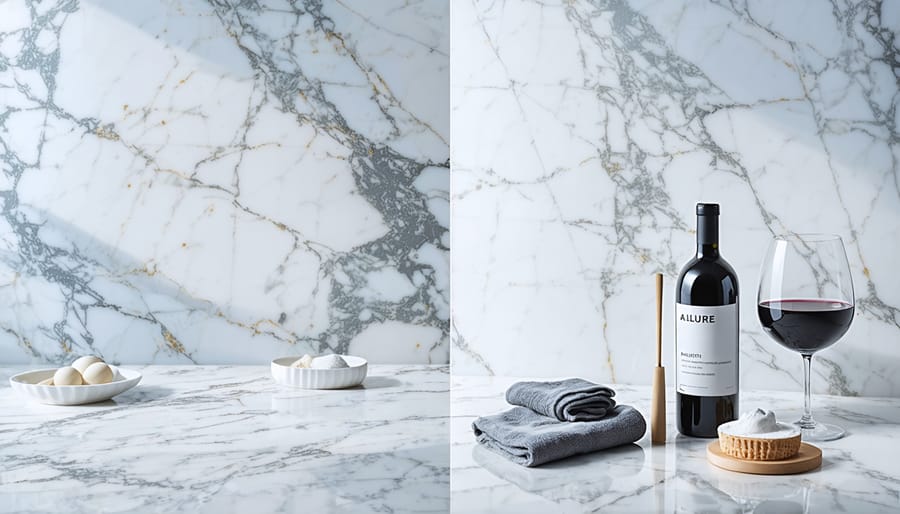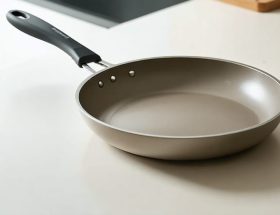Marble demands respect, not fear. While the timeless beauty of marble captivates homeowners, its maintenance requirements often raise concerns. This natural stone requires consistent but manageable care—not unlike maintaining a luxury vehicle or fine wooden furniture. Daily wiping with a pH-neutral cleaner, immediate attention to spills (especially acidic substances), and annual sealing form the cornerstone of marble care. Understanding these requirements upfront helps homeowners make informed decisions about whether marble’s distinctive elegance justifies its care routine.
The truth is, marble maintenance falls somewhere between routine care and periodic attention. While it’s more demanding than granite or quartz, it’s far from the high-maintenance reputation that sometimes precedes it. Modern sealants and cleaning products have simplified marble care significantly, making it a viable option for busy households who appreciate natural stone’s unique characteristics and are willing to implement basic care protocols.
The Truth About Marble Maintenance
Marble’s Natural Characteristics
Marble, while undeniably beautiful, comes with inherent characteristics that directly influence its maintenance requirements. The stone’s porous nature means it readily absorbs liquids, making it susceptible to staining if spills aren’t promptly cleaned. This porosity varies between different marble varieties, with some being more absorbent than others.
Perhaps marble’s most notable sensitivity is its reaction to acidic substances. Common household items like lemon juice, vinegar, and wine can etch the surface, creating dull spots that alter the stone’s appearance. Even everyday products like tomato sauce or coffee can potentially damage the surface if left unattended. This occurs because marble contains calcium carbonate, which naturally reacts with acids, essentially dissolving the surface layer.
The stone’s softer composition, compared to materials like granite, also makes it more vulnerable to scratches and wear patterns over time. These natural characteristics don’t make marble impractical, but they do require owners to understand and respect the material’s properties. With proper sealing and maintenance protocols in place, these inherent sensitivities can be effectively managed.
Common Maintenance Challenges
Marble’s elegance comes with several maintenance challenges that owners should be prepared to address. The most significant issue is etching, which occurs when acidic substances like lemon juice, vinegar, or wine come into contact with the surface, leaving dull marks that alter the stone’s finish. These etch marks are particularly noticeable on polished marble and can be difficult to remove without professional intervention.
Staining is another common concern, as marble’s porous nature makes it susceptible to absorbing liquids. Red wine, coffee, oils, and even water can penetrate the surface if left unattended, creating permanent discoloration. While proper sealing helps prevent stains, it’s not foolproof and requires regular reapplication.
Scratching can occur from everyday use, especially in high-traffic areas or when dragging objects across the surface. Even seemingly harmless items like ceramic dishes or metal utensils can leave visible marks on marble. While light scratches can often be buffed out, deeper scratches may require professional restoration to maintain the stone’s aesthetic appeal.
These challenges don’t make marble unsuitable for use, but they do require vigilant care and prompt attention to spills and damage to maintain its beauty.
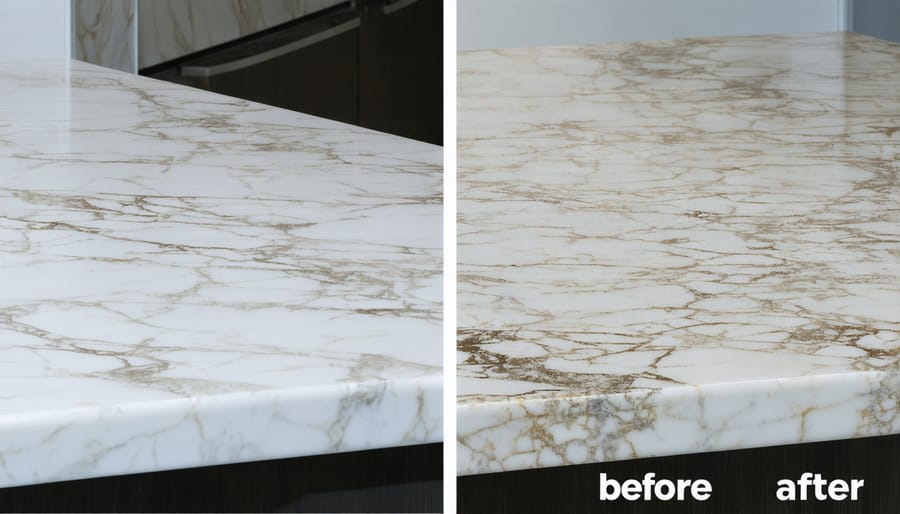
Essential Daily Care Requirements
Cleaning Protocols
Maintaining marble requires following specific expert marble care techniques to preserve its beauty and longevity. For daily cleaning, use a pH-neutral cleaner specifically designed for natural stone, along with a soft microfiber cloth or sponge. Avoid acidic cleaners, including vinegar and citrus-based products, as these can etch the surface and damage the stone’s finish.
Always clean spills immediately, particularly those from acidic substances like wine, citrus juices, or tomato sauce. Blot rather than wipe spills to prevent spreading the liquid across a larger surface area. For stubborn stains, use a poultice specifically formulated for marble.
Establish a regular cleaning routine that includes:
– Daily wiping with a damp cloth
– Weekly cleaning with a stone-specific cleaner
– Monthly inspection for signs of wear or damage
– Biannual sealer application (or as needed based on wear)
Use coasters under glasses, trivets under hot items, and cutting boards for food preparation to minimize direct contact with the surface. Consider keeping a stone care kit readily available, which should include:
– pH-neutral stone cleaner
– Microfiber cloths
– Stone-safe polishing compound
– Quality stone sealer
– Soft cleaning brushes
With proper care and attention to these protocols, marble can maintain its luxurious appearance for years to come.
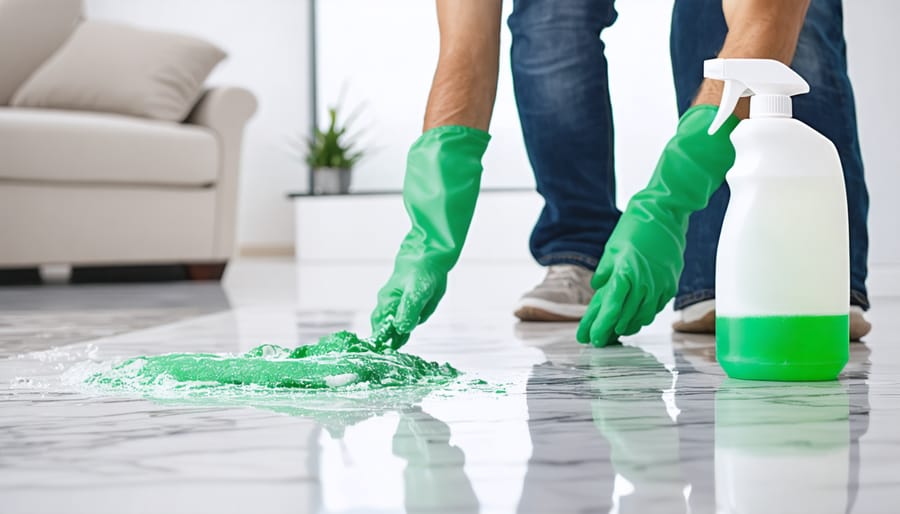
Preventive Measures
While marble requires regular maintenance, implementing preventive measures can significantly reduce the need for intensive care. Start by using coasters under glasses and placing protective pads beneath kitchen appliances or decorative items. Always clean spills immediately, especially acidic substances like wine, citrus juices, or vinegar, which can etch the surface.
In kitchen areas, use cutting boards and avoid placing hot pots directly on marble surfaces. Consider applying a high-quality sealer every 6-12 months, depending on usage, to maintain the stone’s protective barrier against stains. For flooring applications, place mats at entrances to minimize abrasive dirt and debris tracked onto marble surfaces.
When cleaning, use pH-neutral cleaners specifically designed for natural stone. Avoid generic household cleaners, which may contain harsh chemicals that can damage the marble’s finish. Regular dust mopping of marble floors and gentle wiping of countertops with a soft, damp cloth helps prevent scratch-causing particles from accumulating.
For bathroom applications, ensure proper ventilation to prevent moisture accumulation, which can lead to dulling of the surface over time. Use non-abrasive bathroom products and keep personal care items on trays or holders rather than directly on marble surfaces. These simple yet effective preventive measures can help maintain marble’s beauty while reducing the frequency of intensive maintenance procedures.
Long-term Maintenance Schedule
Sealing Requirements
Marble requires regular sealing to maintain its beauty and protect against staining. Most experts recommend sealing marble countertops every 6-12 months, though high-traffic areas may need more frequent attention. The frequency depends on factors like usage patterns, cleaning habits, and the quality of the previous sealing job.
To determine if your marble needs resealing, perform a simple water test: sprinkle a few drops of water on the surface. If the water beads up, your seal is still effective. If it absorbs within a few minutes, it’s time to reseal.
Following proper sealing methods is crucial for optimal protection. Start with a thoroughly cleaned and dried surface. Apply a high-quality penetrating sealer specifically designed for marble, using a soft cloth or applicator pad. Allow each coat to absorb for 15-20 minutes before buffing away excess product. Most surfaces require two coats for complete protection.
While sealing is an essential maintenance task, it’s relatively straightforward and typically takes less than an hour to complete. The key is consistency and using appropriate products designed for natural stone.
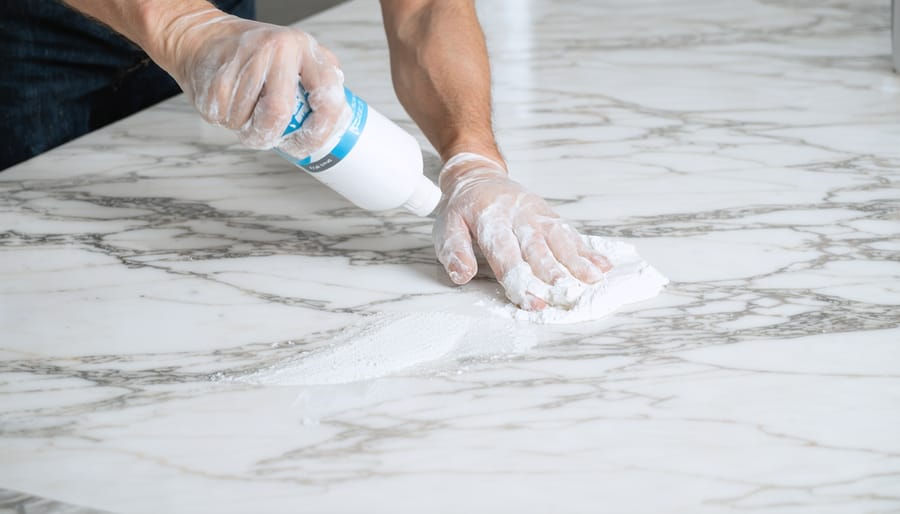
Professional Services
While regular maintenance can be handled by homeowners, certain marble care tasks require professional expertise. Professional stone restoration specialists should be called for deep cleaning, removing stubborn stains, repairing chips or cracks, and performing complete surface restoration. Experts recommend professional polishing or honing every 3-5 years, depending on wear patterns and usage.
Professional services typically include:
– Deep cleaning using specialized equipment and products
– Stain removal treatments
– Scratch and etch mark removal
– Chip and crack repairs
– Complete surface restoration
– Sealer application
– Professional polishing or honing
When selecting a service provider, look for certified stone care professionals with experience specifically in marble restoration. Request references and examples of previous work. Professional services can cost between $200-$1,500, depending on the scope of work and surface area. While this may seem expensive, professional maintenance helps preserve your marble’s beauty and value, potentially preventing more costly repairs or replacement in the future.
Many stone care professionals also offer maintenance plans and can provide guidance on daily care routines to extend the time between professional services.
Making Marble Work for You
Time-Saving Maintenance Tips
While marble requires regular care, these time-saving tips can streamline your maintenance routine. Keep a microfiber cloth near your marble surfaces for quick daily wipe-downs, which prevent stain buildup and reduce deep cleaning needs. Use placemats and coasters consistently to minimize cleaning frequency and protect against etching.
Create a cleaning kit with marble-specific products and keep it easily accessible. This saves time searching for supplies and ensures you’re always using the right products. Implement a weekly cleaning schedule using pH-neutral cleaners rather than waiting for visible dirt to accumulate.
Consider applying a high-quality sealer annually, which reduces daily maintenance requirements by providing better stain resistance. Install soap dispensers and toothbrush holders that don’t contact the surface directly in bathrooms to prevent soap scum buildup.
For kitchen countertops, use cutting boards and prep stations to contain messes and minimize cleanup time. Keep acidic substances in designated areas away from marble surfaces to reduce the risk of accidental spills and subsequent cleaning efforts.
Cost-Effective Care Solutions
Maintaining marble doesn’t have to break the bank. Many effective cleaning solutions can be made using household items like mild dish soap and warm water, which work just as well as expensive specialty cleaners. For daily cleaning, a microfiber cloth and this simple solution will suffice, saving you money on commercial products.
Consider investing in a high-quality penetrating sealer, which, while initially more expensive, can last several years when properly applied. This upfront cost reduces the need for frequent resealing and potential repairs. For stain prevention, inexpensive items like coasters, cutting boards, and placemats can protect your marble surfaces from damage that would require costly professional intervention.
DIY polishing can be achieved using marble polishing powder and a buffing pad, which is significantly cheaper than professional services. For minor etching, a combination of baking soda and water can create an effective paste for gentle buffing. Regular maintenance using these budget-friendly methods can extend the time between professional services, making marble care more economical in the long run.
Remember to address spills immediately with paper towels to prevent staining, eliminating the need for expensive stain removal treatments later.
While marble does require more attention than some other countertop materials, its maintenance requirements shouldn’t deter you from choosing this timeless natural stone. With proper care and routine maintenance, marble countertops can retain their beauty and functionality for generations. The key lies in understanding and following basic care guidelines: using appropriate cleaning products, promptly addressing spills, applying sealant as needed, and being mindful of potential etching agents.
The maintenance investment pays off through marble’s unmatched elegance, unique character, and ability to increase property value. Each piece tells its own story through distinctive veining patterns and natural variations, making your space truly one-of-a-kind. While alternatives like quartz or granite might require less upkeep, they cannot replicate marble’s authentic luxury and timeless appeal.
Consider marble maintenance as part of your home care routine rather than a burden. By incorporating simple preventive measures and developing good habits, you can effectively protect your investment. Remember that even with some wear over time, marble often develops a beautiful patina that adds to its character and charm.
For those who appreciate natural stone’s beauty and are willing to provide proper care, marble remains an excellent choice that combines luxury, durability, and timeless appeal. The maintenance requirements, while higher than some alternatives, are manageable with the right approach and commitment to care.

